Related Content
Content

When slow is the way to go
When there is a choice of routes, discover why taking the slower trains can be the better option.
Share
Fast trains and dramatic landscapes don't usually exist together in happy harmony, express trains need straight lines to attain their maximum velocity, so hills, mountains and rivers are obstacles in their way that require tunnels, which inevitably then shield travellers from the views.
The age of the high speed train has amplified this contrast, because transporting people from A to B quicker than ever before has, on occasion, led to brand new railways being constructed some distance away from the older routes that they have superseded.
Though usually the older routes couldn't be abandoned entirely, so the slower trains which call at the local stations, still travel along them.
Those high speed lines have inevitably enabled journeys by train between distant cities to be faster and easier than ever before, but for those willing to make connections, in order to enjoy more dramatic landscapes, the network of the older railways enable alternative more beautiful routes to be taken.
And for those using rail passes, these indirect journeys are cheaper as well as more dramatic!
Milan ↔ Zurich
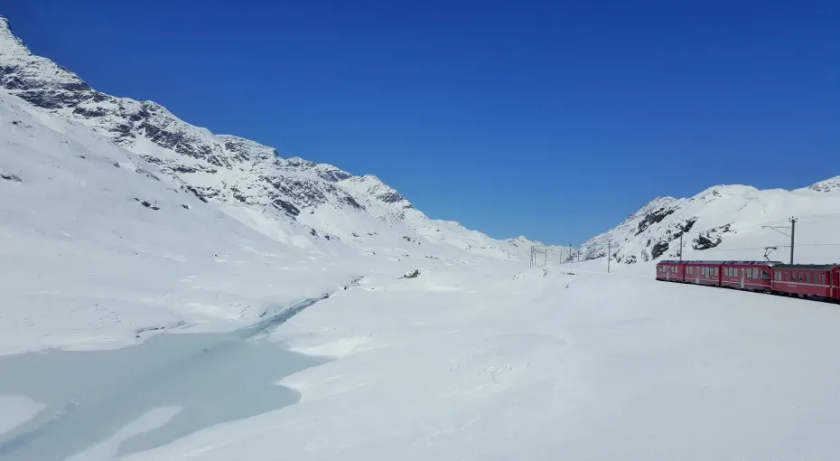
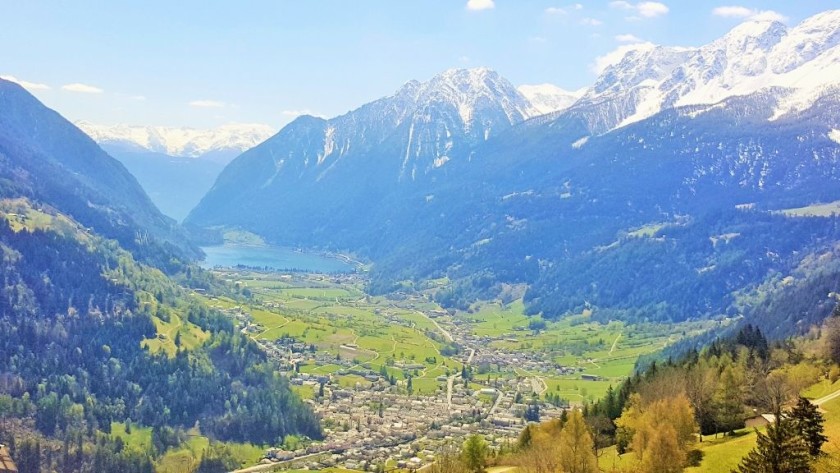
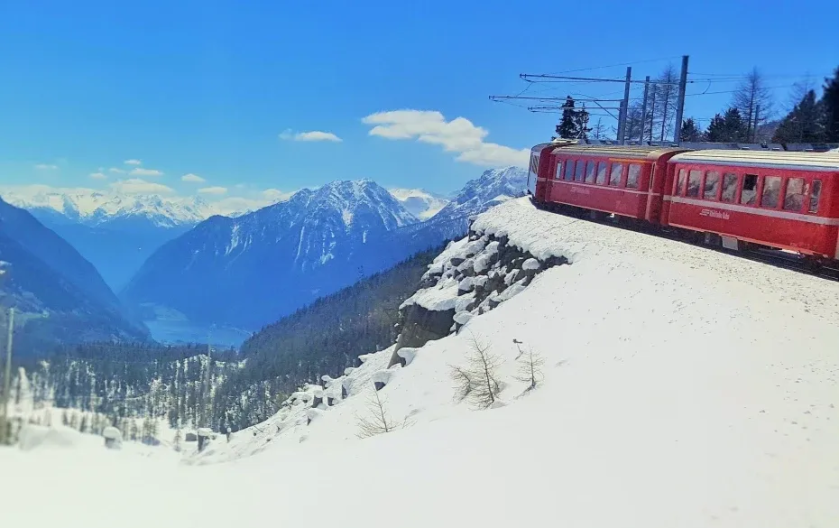

Taking the slow route = 9hr 30min approx
by direct train = 3hr 30min approx
Rail pass users save = €11-13
The journey by direct trains between MIlano and Zurich is rather wonderful, though in recent years it has become less exceptionally dramatic.
That has occurred due to the opening of two huge tunnels through the Swiss mountains, which now divert the fast trains between the two cities, away from what had been many of the most scenic moments which could be seen from a European express train.
However, for those willing to trade convenience for an unforgettable experience, there is a less obvious route to follow when travelling between Milano and Zurich by train.
The Bernina Railway railway which links the Italian border town of Tirano to St Moritz...
.. and the Albula Railway, that takes travellers on to Chur...
...are two of the absolutely most beautiful of the Swiss Mountain Railways.
At face value these two routes seem tucked away in the the south-east corner of Switzerland, but in actuality they are two links in a chain of spectacular railways that connect Milano and Zurich.
The Bernina and Albula Railways are part of the network of Rhaetian Railway routes in this part of Switzerland, which despite being located in an Alpine area, are operated as though they are a metro system, with a remarkable synchronisation between trains.
So when travelling by the Rhaetian railway's regular trains from Tirano to Chur, making the necessary connections is as simple as can be, you step off one train and wait for a few minutes for the onward train to arrive.
Though what isn't so obvious is that the optimum route between Tirano and Chur isn't to travel by St Moritz, instead the timetable is arranged to enable easy connections at Pontresina and Samedan stations.
There are trains either every hour, or in alternate hours, which link Milano Centrale to Tirano, and they take a beautiful route along the eastern shore of Lake Como
The railway line travels by the shore of the lake for more than 30 minutes between Lecco and Colico.
Then after Colico the foothills of The Alps can also be seen on the left
In Tirano these trains from Milano use a station, which is merely steps away from the Rhaetian Railway station in the town.
Chur and Zurich are connected by frequent Swiss express IC trains, which also take a beautiful route by two lakes; and they are timed to make connections in and out of the Rhaetian Railway's trains of less than five minutes.
So the efforts to make connections in Tirano, Pontresina, Samedan and Chur will be rewarded by more than eight hours of travel through stunning landscapes.
Innsbruck also has an easy link to and from Chur, with another change of train in Buchs.
Rail pass users can avoid any having to pay the mandatory rail pass reservation fees on the direct EC trains from and to Italy by taking the Rhaetian routes to and from Zurich or Innsbruck.
Travelling by The Bernina Express
Though for those travelling with and without rail passes who will baulk at the idea of having to make quite so many connections when travelling this route between Milano and Zurich, there is a simpler alternative, because The Bernina Express operates direct between Tirano and Chur
Though when travelling north, the connections from the 09:20 train from Milano, involve spending more than two hours in Tirano; so time enough for a leisurely lunch in the town.
The Bernina Express will then arrive in Chur at 18:20 and will have connections available on to Zurich.
Heading south the connections in and out of The Bernina Express are more straightforward; they typically involve departing from Zurich at 12:07, and arriving in Milano at 20:40.
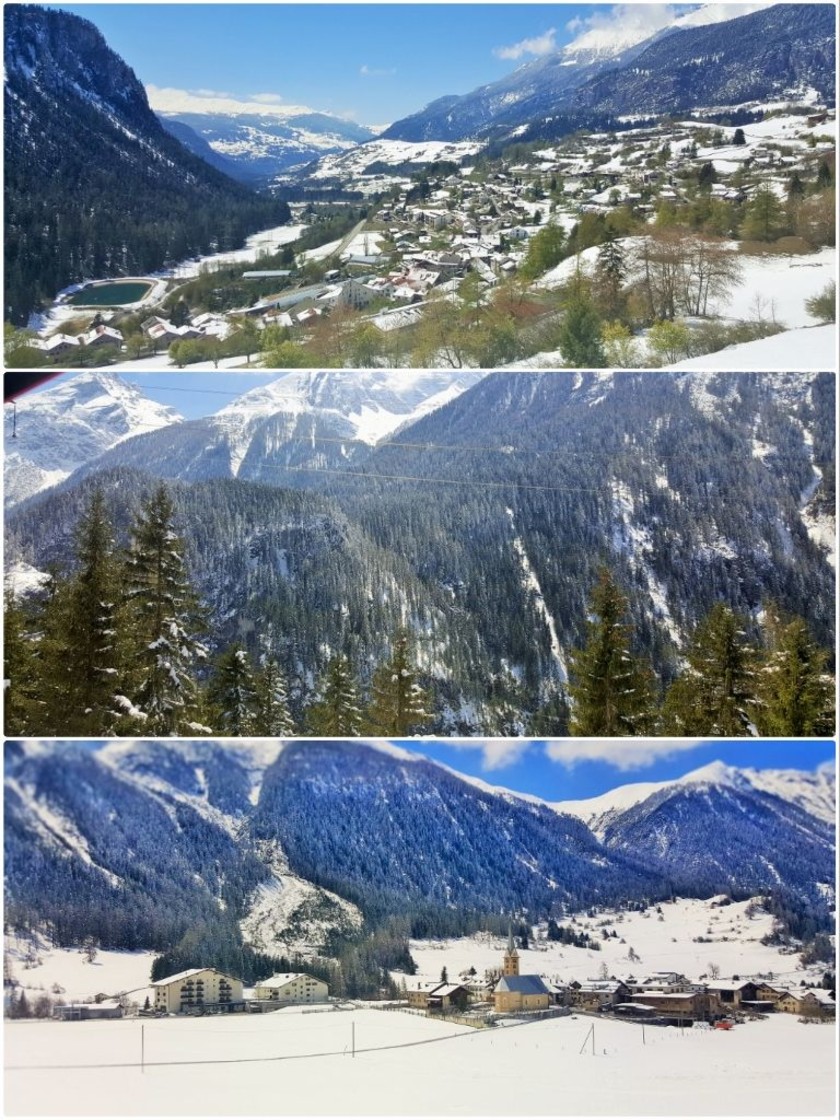
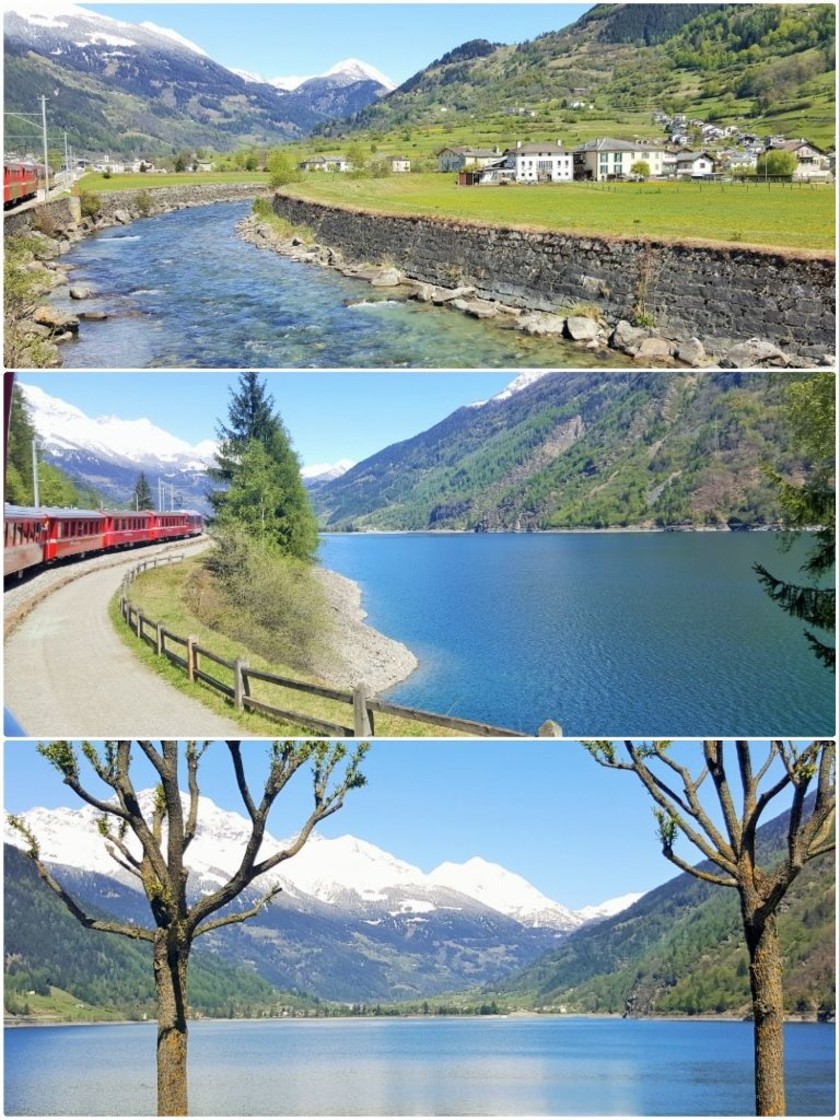
Paris or Lyon ↔ Nîmes
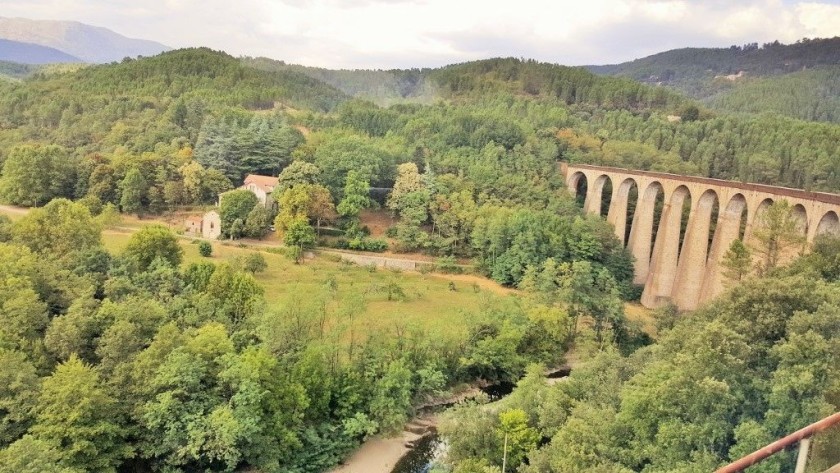
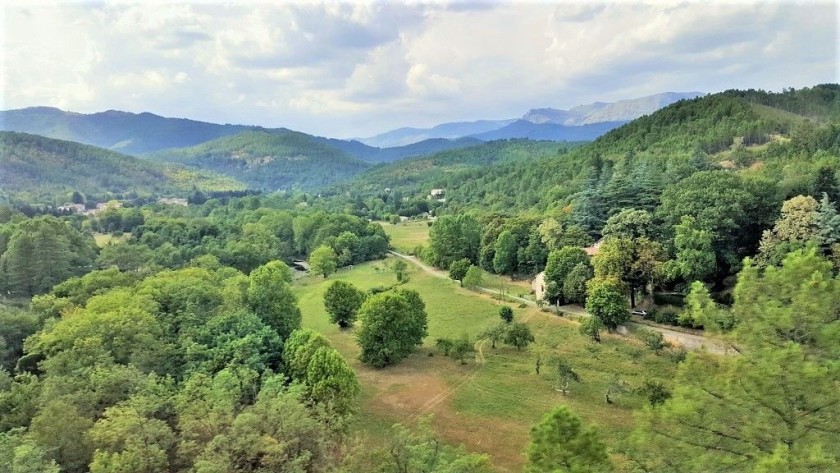
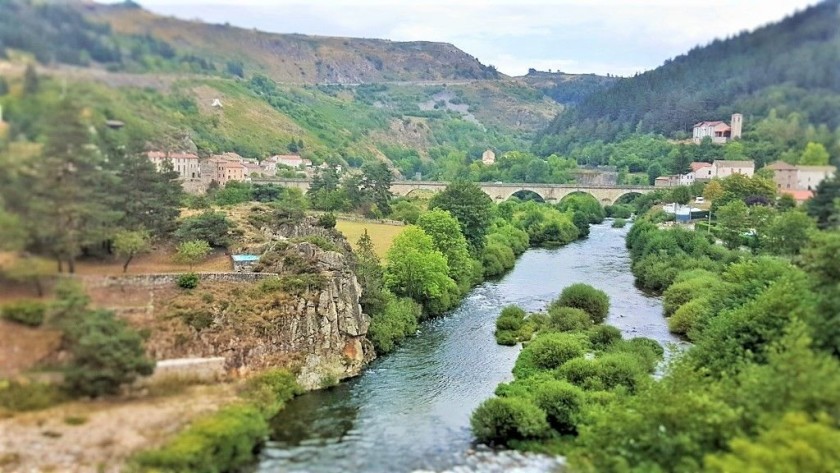
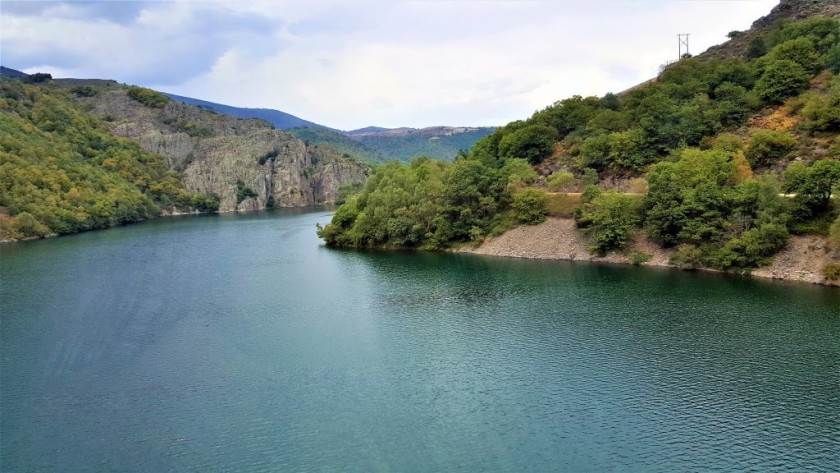
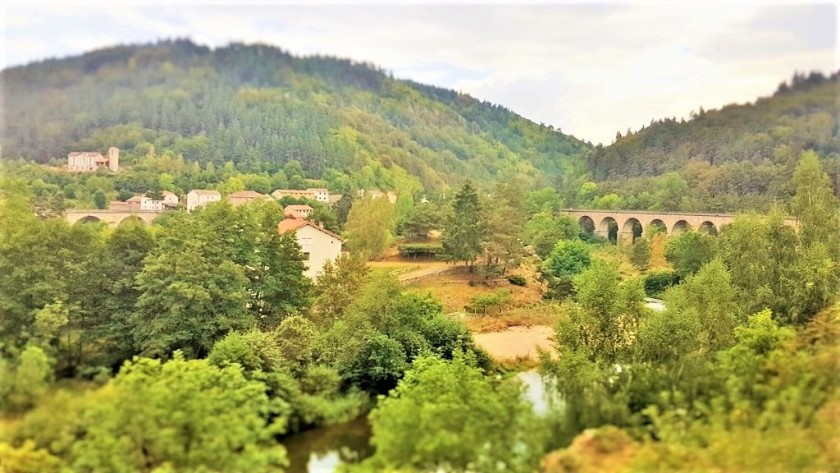

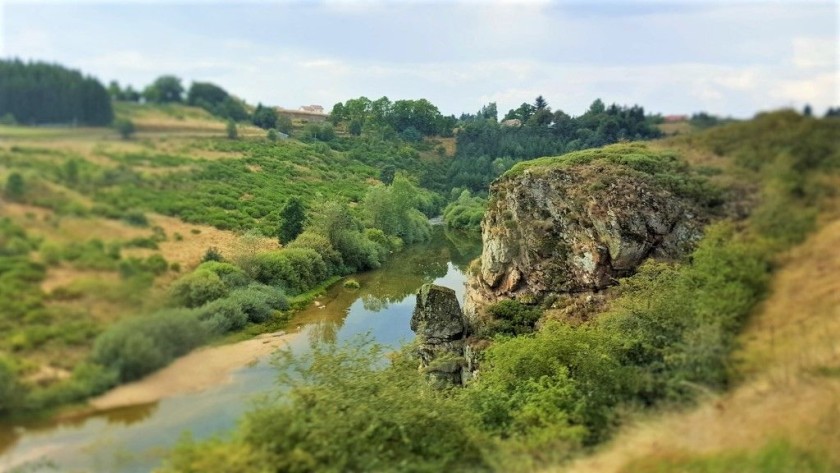
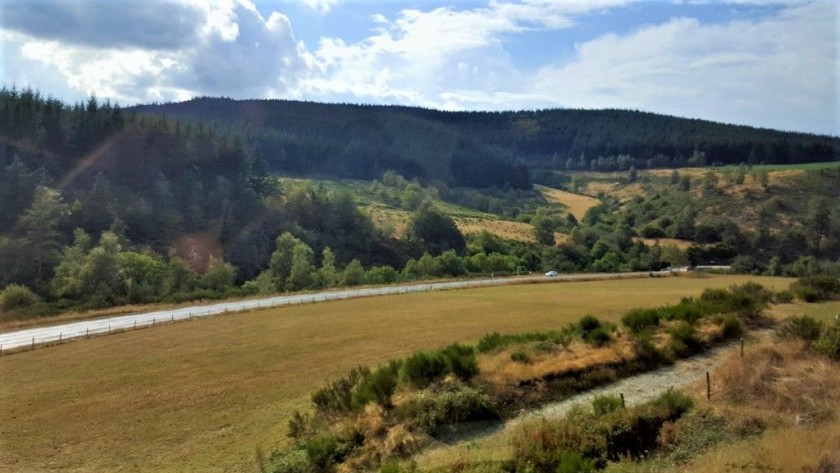
Taking the slow route to/from Paris = 8hr 30min - 9hr 5min approx
Taking the slow route to Lyon = 8hr 15min approx
by direct train to/from Paris = 3hr approx
by direct train to Lyon = 1hr 25min approx
Rail pass user's save at least €10 when travelling to/from Lyon; and to Paris
As will be seen from those journey times, if you will be using tickets to travel this route, you'll need to be the type of traveller who is wowed by landscapes to travel this way.
Though when tickets for the direct trains between Paris and Nîmes are at their most expensive, there's a possibility of saving money too.
However, if you'll be using InterRail or Eurail passes you will save money, as it's possible to avoid the TGV and Intercités trains on which rail pass users have to pay mandatory reservation fees; though the connections are much more convenient when heading north to Lyon and Paris.
So why spend more than twice as long on a train when travelling from or to Nîmes?
Well on the rail map of Europe, the scenic routes have green borders and when looking at France on the map, there is one north ↔ south railway line which stands out more than any other, because it is 'green' for virtually its entire length and it is this route between the cities of Nîmes and Clermont-Ferrand.
It is also known as the 'La Ligne Da Cevenne', taking its name from the national park which it traverses.
The railway is so wonderful that it merited an episode in a TV series named 'The World's Most Scenic Railway Journeys', broadcast in the UK by Channel 5.
The train will spend more than three hours travelling through one of the most beautiful areas of France, but it is a journey with two distinct highlights, one of which is the crossing of Le viaduc de Chamborigaud; views from railway bridges/viaducts don't get more spectacular than this.
Sit on the left of the train and look out when the train departs from Chambirogaud station, around 1hr 5mins into the journey.
The other highlight of the journey isn't over so quickly, as for more than 30 mins north of Villefort, the train will travel a spectacular passage through a series of deep river valleys, the Gorges De L'Allier; when heading north the river here is on the left, so sit on the right when going south.
Then between the 'Gorges' and Langeac the railway follows the river through a wider valley and on this part of the journey there are great views from both sides of the train.
The practical info for making the journey
When travelling this way between Nîmes and both Lyon and Paris connections between trains are required in Clermont-Ferrand.
On the usual timetable a daily train typically departs Nîmes for Clermont-Ferrand at 08:16; and this morning departure ensures a passage in daylight year round.
On arrival in Clermont-Ferrand there will typically be a connection of around 10mins into an Intercités train on to Paris Bercy station, which is due to arrive in the French capital before 17:00.
From this 08:16 departure from Nîmes there should also be a connection of around 30 mins in Clermont-Ferrand for a train on to Lyon.
Rail pass users who also want to avoid paying the mandatory rail pass reservation fee of at least €10 to travel by that Intercités train to Paris, can take another TER train on from Lyon to Paris.
In the opposite direction heading south, an Intercités train which usually departs Paris-Bercy at 08:57 has a good connection in Clermont-Ferrand into a train that is due to arrive in Nîmes just after 18:00.
However, the connections from Lyon are much less convenient than when heading north, as the time between trains in Clermont-Ferrand is more than two hours.
Bern ↔ Brig
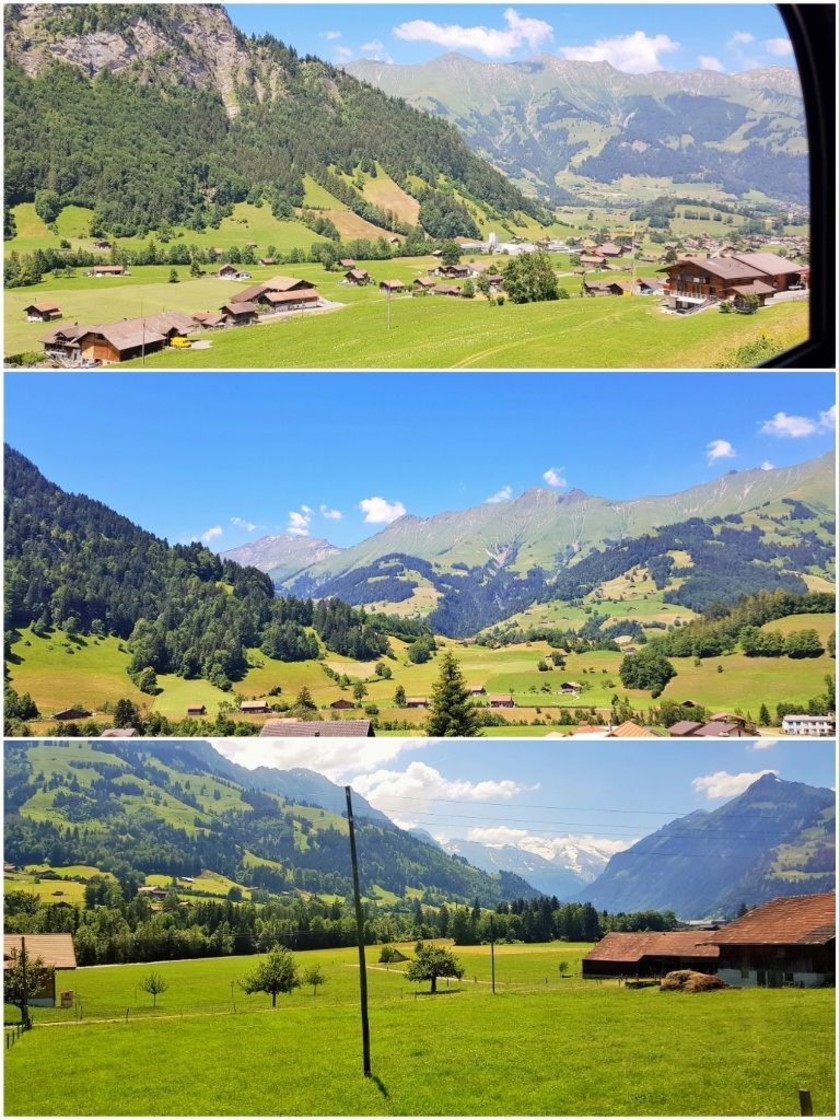
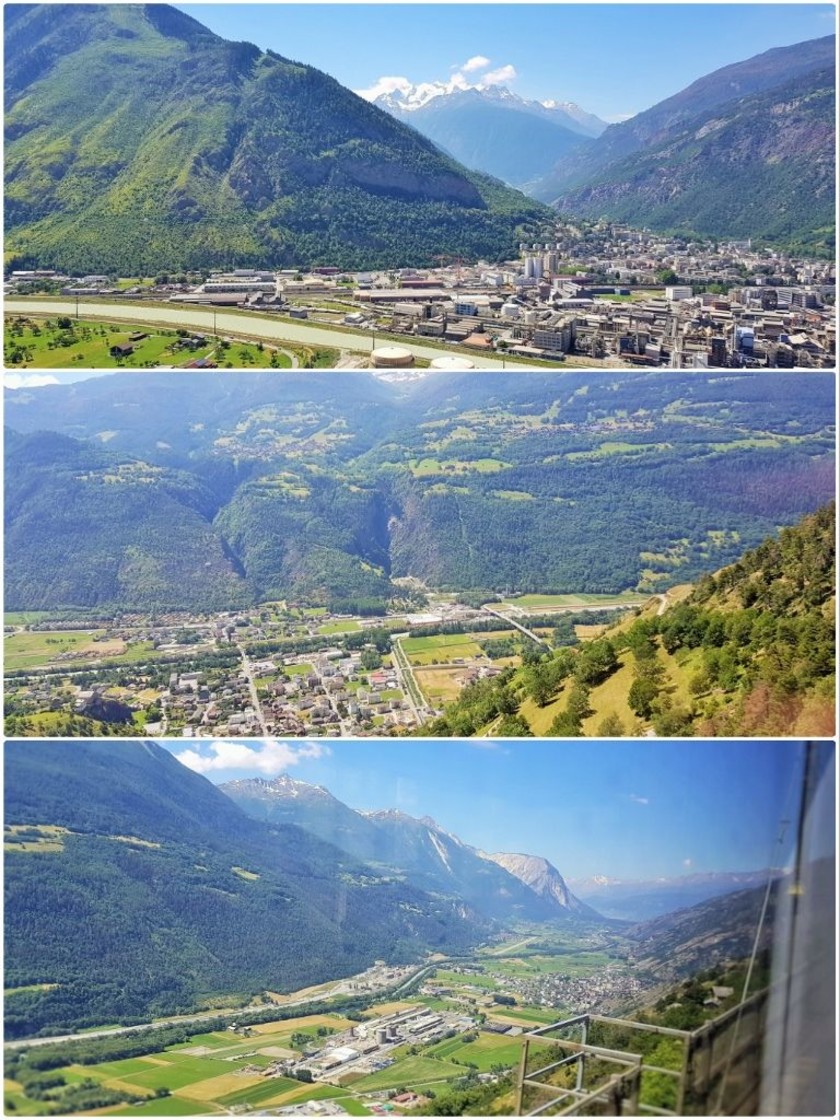
slow trains = 1hr 45min approx
express trains = 1hr 5min approx
When the railways routes which cross Switzerland from north to south were constructed in the first decade of the 20th century, they required tunnels to be dug which at the time were of record breaking length.
The Lotschberg Tunnel was the second-longest railway tunnel in the world when trains began to use it, and the record-holder was The Simplon Tunnel a few miles to the south of it; the town of Brig is located between these two tunnels.
However, this awesome feat of engineering was inadequate for the 21st century hence the opening of the then record-breaking Lotschberg Base Tunnel which the express IC and EC trains that travel between Bern and Brig now use.
Though the older Lotschberg Tunnel and the route through it couldn't be abandoned, because it has stations at Frutigen and Kandersteg which give access to some of Switzerland's most popular skiing areas.
So hourly regional trains in each direction, which are branded 'Lotschberger' still take the route through Kandersteg, but it isn't the journey through the older tunnel which is the reason for taking these trains.
The tunnel houses the highest point on the Swiss rail network used by regular trains, but the town of Brig is down on the banks of The River Rhone.
Hence the spectacular part of this journey is what the legendary railway writer G. Freeman Allen referred to as the 'descent to Brig', which by default becomes the ascent up from Brig when heading north.
The views (which can be seen on the right when heading south and left when heading north) from the top, are some of the most incredible on any Swiss railway journey.
It's possible to look down, with an aura of superiority, on the trains which will be travelling in and out of the newer Lotschberg Base Tunnel.
The part of the journey between Kandersteg and Frutigen, which the express trains now also skip, is also rather wonderful.
So if you will be travelling in Switzerland with a rail pass, it's definitely worth taking the time to slow down and take the Lotschberger trains.
Though users of Eurail and InterRail 'global' passes can also save money when using these trains to travel between Switzerland and Italy, because some of these Lotschberger trains are now international services, because they travel beyond Brig to serve Domodossola in Italy.
Connections are available in Domodossola with Italian Regionale trains between there and Milano, so for rail pass users this is a money saving alternative to taking the cross-border express EC trains.
Basel, Luzern and Zurich ↔ Bellinzona and Lugano
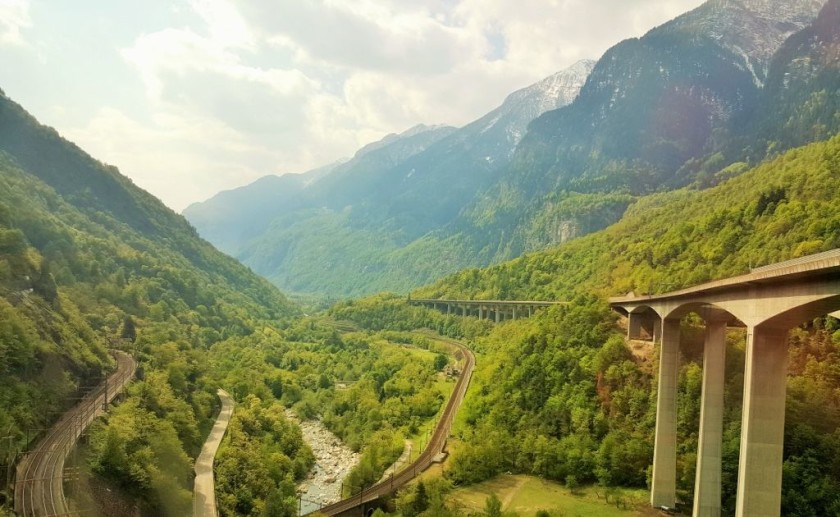
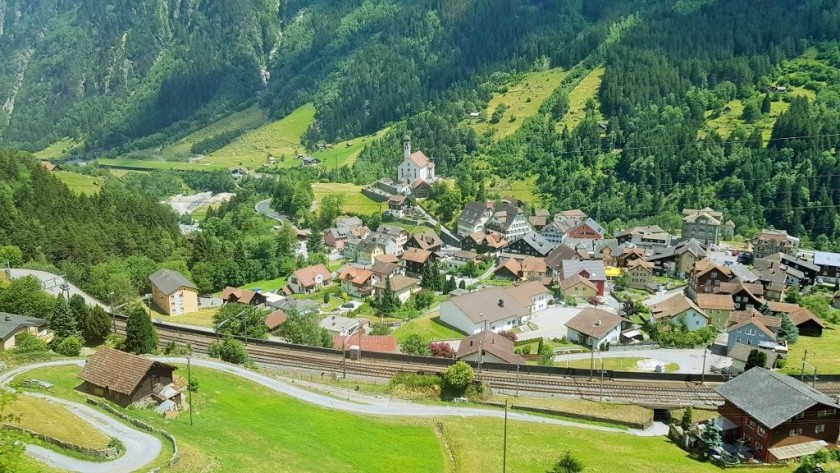
Slow trains between Arth-Goldau and Lugano = 2hr 40 min approx
Express trains between Arth-Goldau and Lugano = 1hr 10 mins
That Lotschbgerg Base Tunnel referenced above didn't hold the record for Europe''s longest railway tunnel used by regular trains for very long, because within a few years it was superseded by the opening of the truly epic Gotthard Base Tunnel.
It has taken the IC and EC trains, which travel between the cities of northern Switzerland and Lugano, away from a contender for the most spectacular route which was once used by European express trains.
So between the junction stations of Arth-Goldau and Bellinzona, the fast trains no longer circle around the spectacular spirals which lead trains up and down from the older Gotthard Tunnel.
These spirals, which enabled the trains to gain height, inevitably provide some of the most incredible views which can be seen from trains in Switzerland.
Since December 2021 the IC and EC trains also miss out what had been another highlight of their journeys, namely the ascent from Bellinzona, because they now travel through the Ceneri Base Tunnel between Bellinzona and Lugano.
Those routes abandoned by the express trains are still used by regional and local trains and a relatively recent development is the IR (InterRegio) trains, which take this older route through Goschenen when travelling between Arth-Goldau and Bellinzona, have had their journeys extended.
As a result they are direct from Basel via Luzern or Zurich to Locarno; alternate trains take each route.
The two routes meet at Arth-Goldau station, so south of there the trains from Basel and the trains from Zurich follow the same path.
South of Bellinzona these same IR trains, which are heading to and from Locarno, also call at junction station named Giubiasco which is served by local trains to/from Lugano.
These local trains don't travel through the Ceneri Base Tunnel on route to/from Lugano, so they take the older route with its wonderful views over the valley which are on the right when heading south, so they're on the left when heading north.
The practical info for making the journey
So when heading south from Basel, Luzern or from Zurich, you'll have a slower, but much spectacular experience if you take those IR trains, which will be heading to Locarno, and then connect in Giubiasco for Lugano.
If you'll be setting off in the hours when no direct trains for Giubiasco are departing Basel, Luzern or Zurich, you can make another straightforward connection in Arth-Goldau.
Rail pass users can hop and off the trains; between Arth-Goldau and Giubiasco there is an hourly service during the day.
Heading north, take the local S-Bahn trains from Locarno on line/route S90 and connect in Giubiasco for an IR train towards Arth-Goldau and beyond.
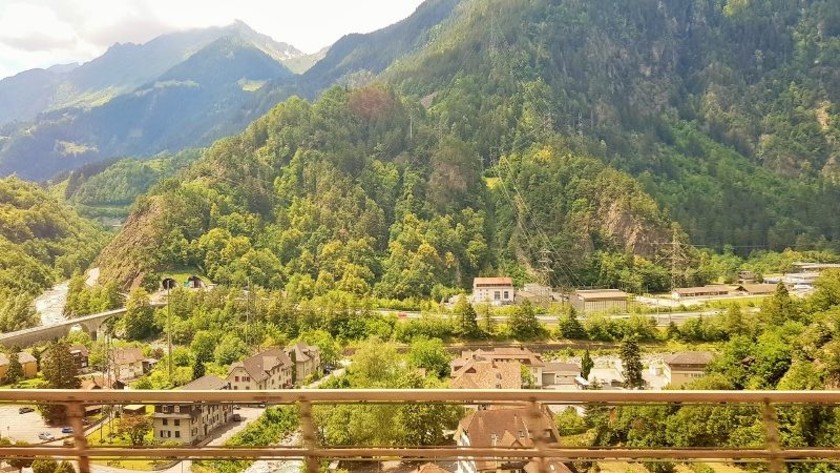
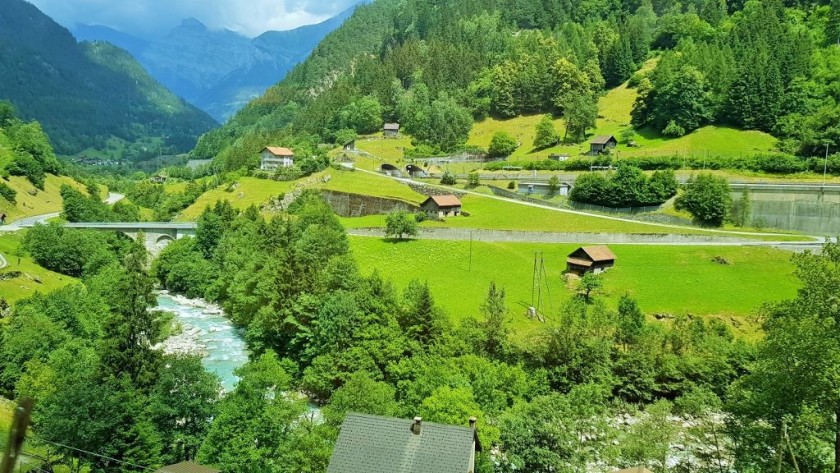
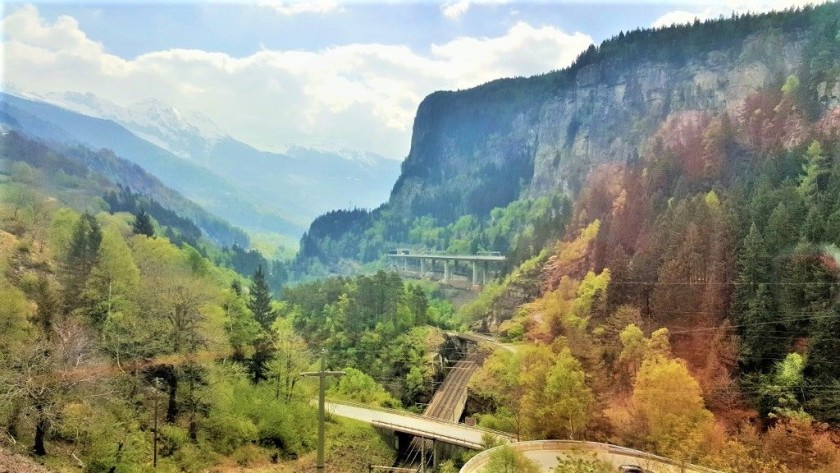
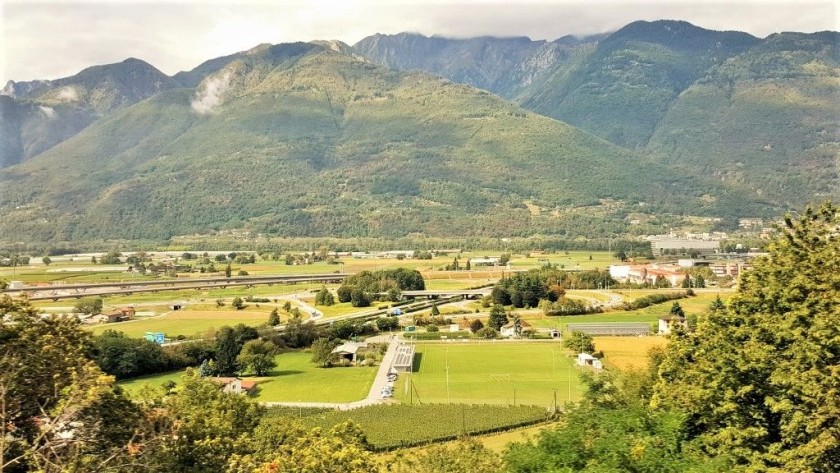
Paris ↔ Milano via Basel
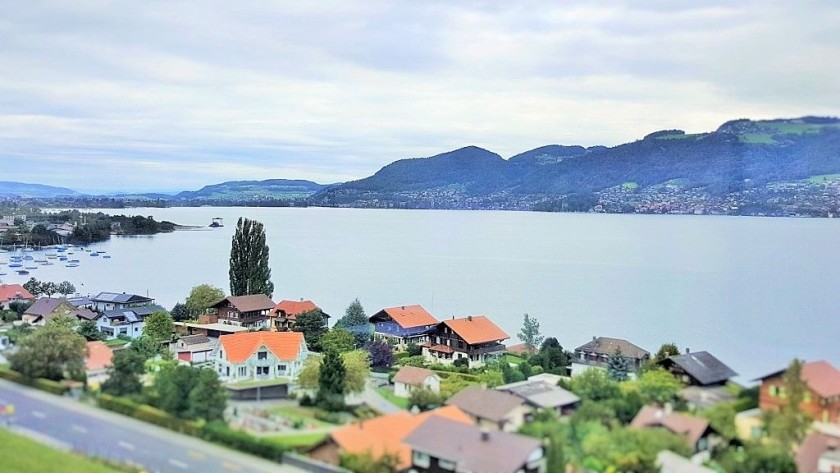
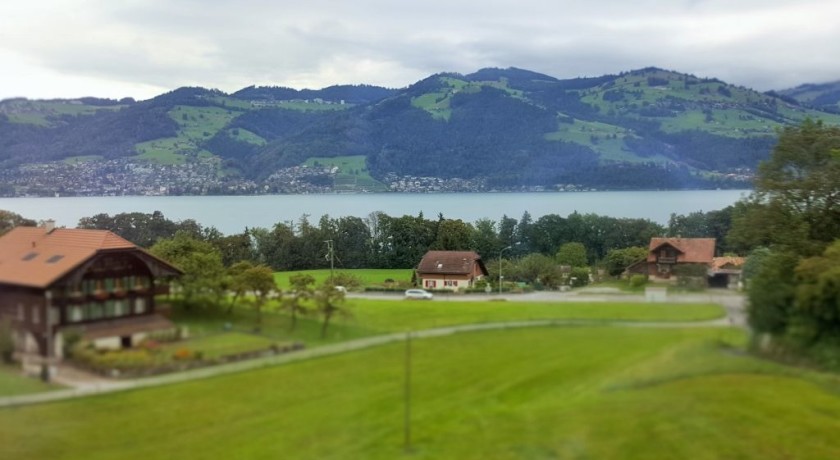

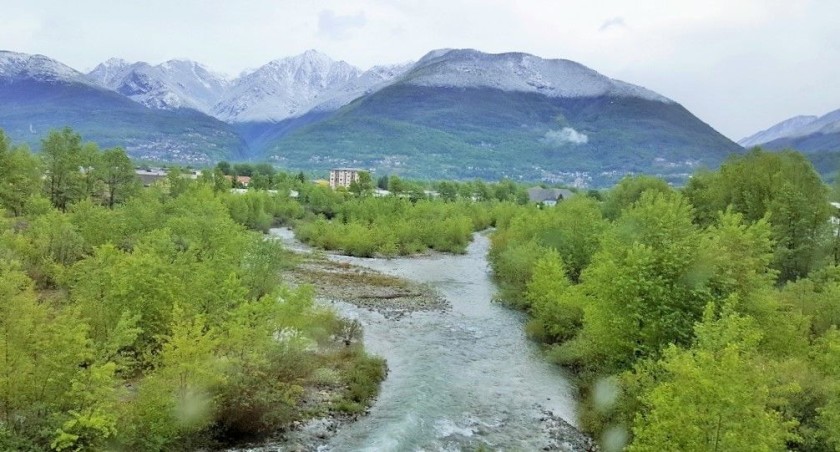

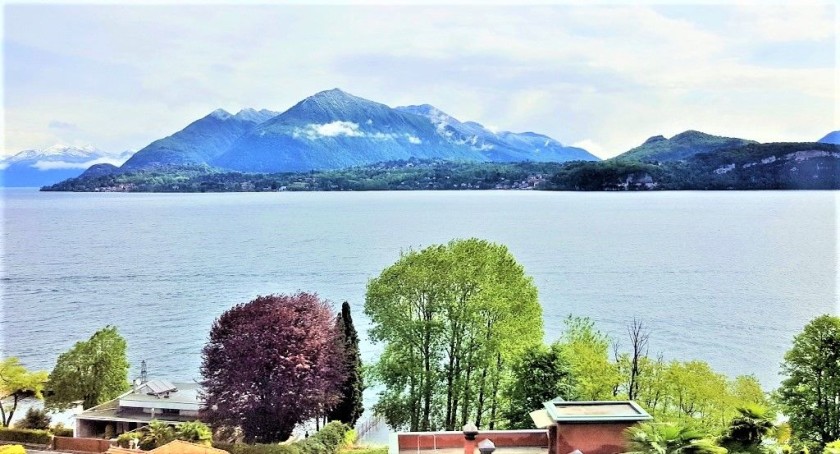
Taking the slow route = 12hr 50min approx
by direct train = 7hr 5min approx
Rail pass users save = more than €30
The combination of high speed route and the passage through the mountains which straddle the Franco-Italian border, give the train journey between Paris a Milan a wow factor
However, the best of the views that can be seen from a direct train between the two cities, are a tad blink and you'll miss them.
This alternative route through Switzerland has many more scenic highlights and if you will be travelling between Paris and Italy with an InterRail or Eurail pass, you can also make a substantial saving.
When heading south you'll also spend a number of hours wondering why you have been sent this way, because all of the best of the views are south of Bern, which is some distance from the French capital.
Though to to the south of Bern you can appreciate;
- Lake Thun, which can be seen on the left after departure from Thun station,
- the railway routes on either side of the Lotschberg Base Tunnel, with the mountains rising up on both sides of the train
- the valley to the south of the The Simplon Tunnel,
- The views over Lake Maggiore, which can be seen on the left to the south of Domodosssola.
All of which are arguably more spectacular than any view that can be seen from the direct Paris ↔ Milano trains.
When looking up the journey between Paris and Milano on a ticketing service you may see an option of travelling between the two cities and making one connection in Basel.
If you do see it offered it will likely be more expensive than taking the direct TGV France/Italy trains, but if the price difference isn't that great, it's definitely worth considering coming this way.
Taking those direct TGV France/Italy trains between Paris and Milano is a particularly expensive option for Eurail and InterRail pass users, so the suggested routing below is much longer, but in addition to being a money saver for rail pass users, it's also more scenic.
- 07:26 from Paris Est to Strasbourg by TER train
- 12:51 from Strasbourg to Basel-SBB by TER train (18 min connection)
- 14:28 from Basel-SBB to Domodossola (20 min connection), this is a Swiss IC train on which reservations are not mandatory
- 18:10 from Domodossola to Milano Porta Garibaldi; arrives 20:14
The train from Domodossola will also call at Stresa and Arona.
This combination of trains, which is only available on Monday to Friday, will enable rail pass users to avoid paying any additional charges.
Though if you'll be booking tickets instead it of using a rail pass, it's highly likely that a combination of only two trains, the Lyria train between Paris and Basel plus the EC train between Basel and Milano, will be cheaper than taking these slower trains.
Rail pass users who will be travelling in the opposite direction and want to make substantial savings, can take this combination of trains:
- 07:25 from Milano Centrale to Domodossola
- 09:58 from Domodossola to Bern
- 12:36 from Bern to Basel SBB
- 14:21 or 14:36 from Basel SBB to Mulhouse-Ville (the train will be heading to Strasbourg)
- 15:22 or 15:25 or 15:35 from Mulhouse-Ville to Paris-Est; arrive in Paris at 20:16
On Saturday and Sunday the connecting time between trains in Mulhouse will only be 12mins, but on Saturday it is possible to depart Mulhouse later and travel on to Paris by connecting again in Belfort.
Paris ↔ Milano via Geneve

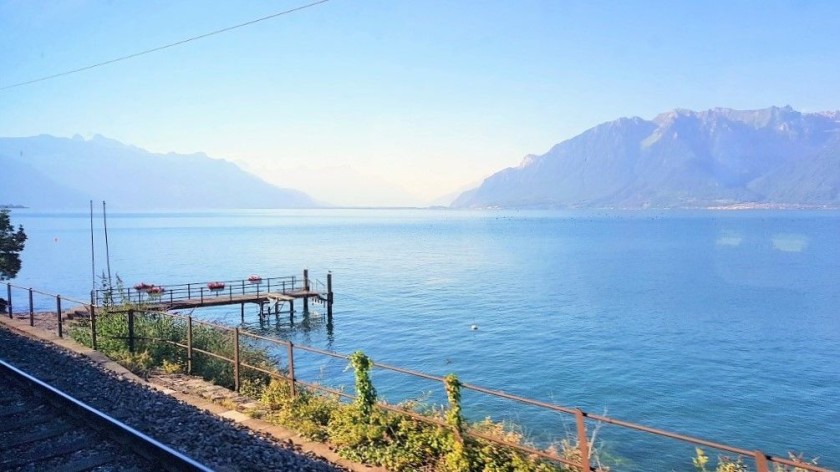
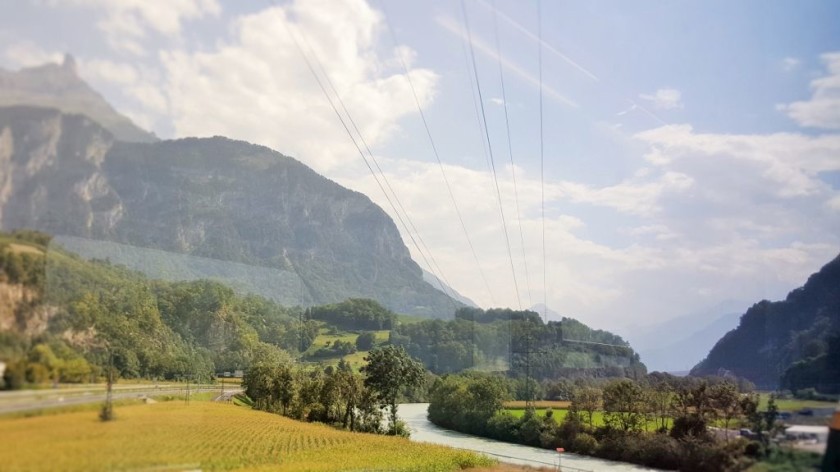
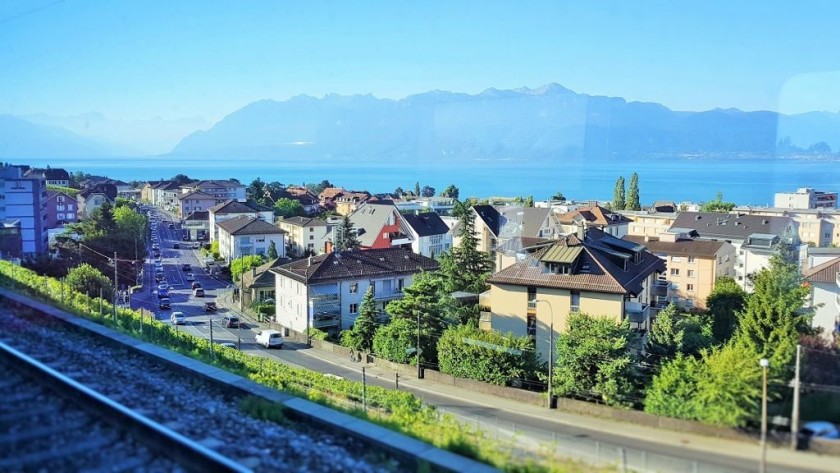
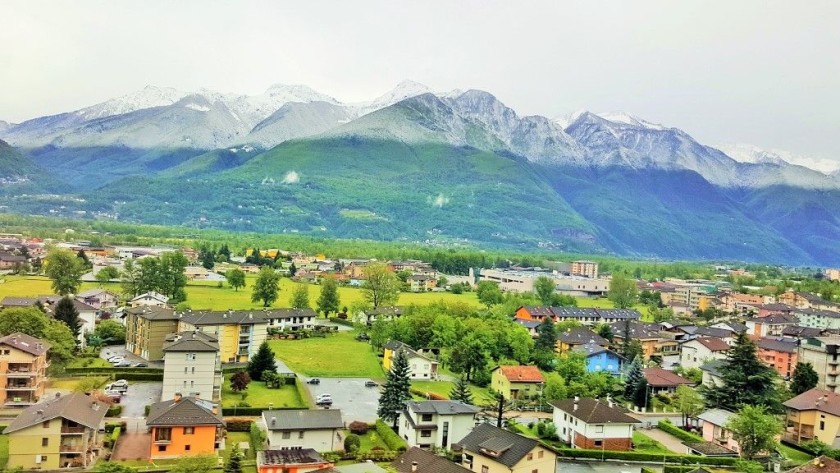
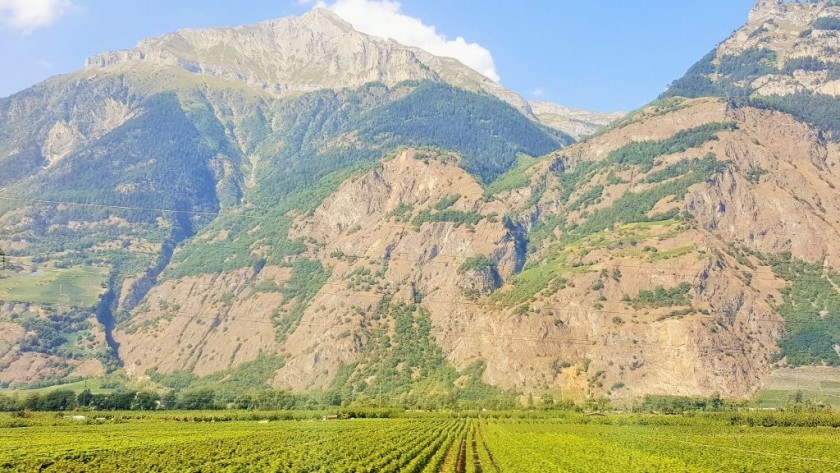
Taking this route = 9hr 20min approx
by direct train = 7hr 5min approx
Before the high speed rail lines in western Europe opened, the fastest train services between major cities were the first-class only TEE trains.
The 'Cisalpin' was the direct TEE service between Paris and Milano and it took this route via Geneve.
However, despite the high speed line now being available for most of the French section of the journey, the direct TGV and Frecce trains between Paris and Milano now take a different route, so that they can also call in Torino/Turin.
So travelling this route now requires a change of train in Geneve, though the connections aren't conveniently timed.
There are only four direct EC trains per day in each direction between Geneva and Milano and heading south a TGV Lyria train from Paris is typically scheduled to arrive in the Swiss city only 10mins before a departure on to Milano, so making the connection in time is quite a gamble.
Heading north the pattern is pretty much repeated, an EC train from Milano is due into Geneve less than 10 mins before the departure of a Lyria on to Paris.
When looking up a Paris ↔ Milano journey on the ticket booking websites this routing via Geneve can often be offered as an alternative to taking the direct trains, but take care to look closely at the transfer time between trains in Geneve
When heading to Milano you'll be able to benefit from a less stressful connection in Geneve if you depart Paris at 08:18; while when heading north from Milano, you'll have more than two hours to make the transfer if you select the connection which typically arrives into the Gare De Lyon at 17:46.
So if the price is similar to taking a direct train, why bother with taking this alternative route, after all the direct trains combine a journey through the mountains with a thrilling rush along a high speed line.
It's because that direct route is eclipsed by the wonders of the journey between Geneve and Milano thanks to its views over Lake Geneva and Lake Maggiore and the passage through the vineyards of The Rhone Valley.
Plus the section of the journey between Geneve and the high speed line in France also has its moments, particularly if you opt to sit on the train's upper deck.
Luzern ↔ Geneve
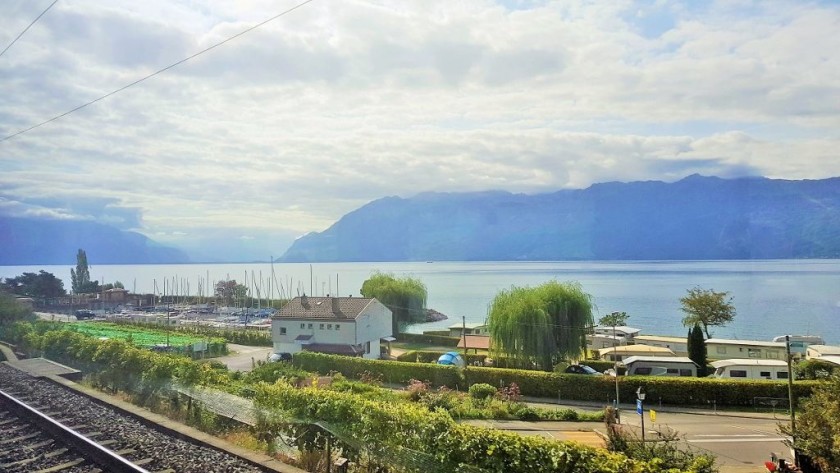
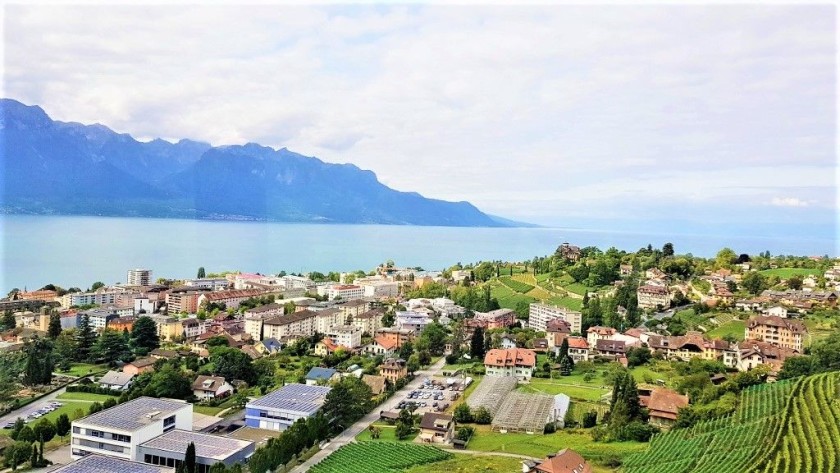
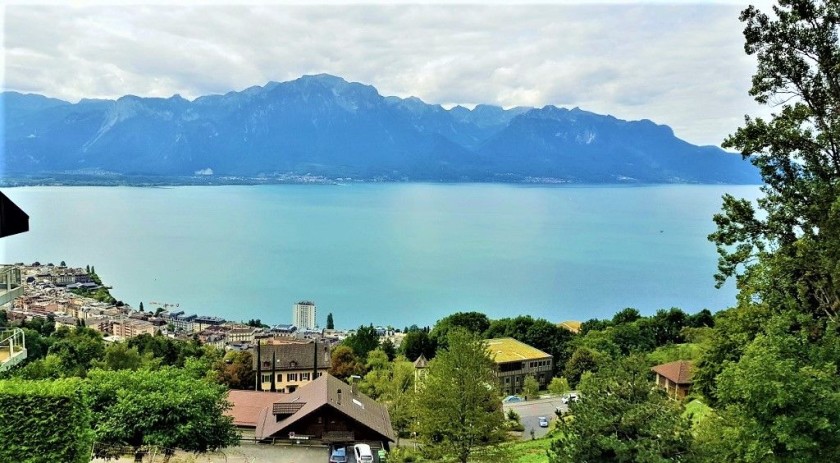

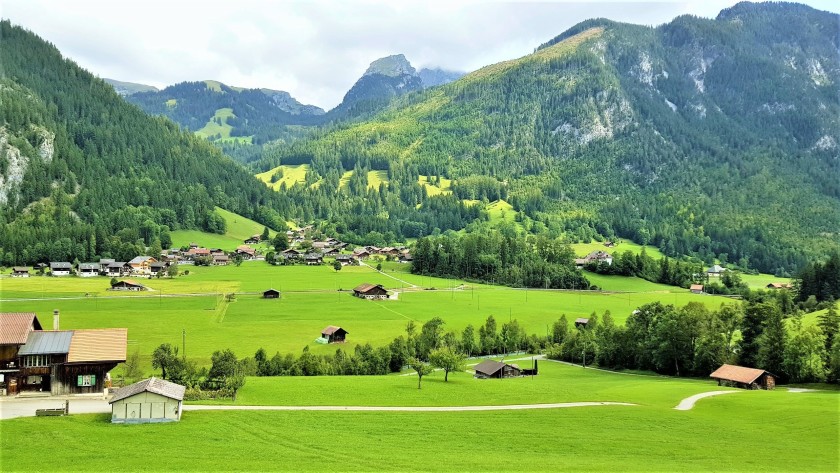
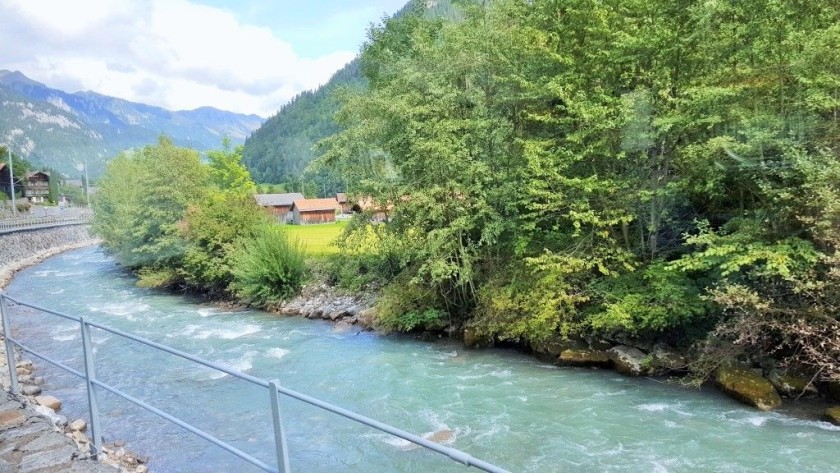
Taking this route = 7hr 50min approx
by direct train = 3hrs approx
The route taken by the direct trains between Geneve and Luzern has one stupendous highlight, namely the fantastic views over Lake Geneva, which can be seen as the trains travel between Lausanne and Fribourg.
But this alternative 'Golden Pass route offers views across the lake that are just as spectacular, plus the journey also has numerous other wonderful moments including the views over the water from down by the lake shore between Lausanne and Montreux.
Yes the journey requires numerous connections, but this is Switzerland, so the transfers couldn't be simpler; and when the connecting time between trains is less than 10 mins, you can rely on being able to hop off one train and on to another.
All of the trains on each part of the route operate at least hourly, so when using a rail pass to explore Switzerland, you can pick any one of the locations in which you'll be changing trains to have a lunch.
East to west the route is:
(1) The Luzern - Interlaken Express from Luzern to Interlaken Ost; sit on the right.
(2) The next train on from Interlaken Ost on the short but lovely journey to Spiez, it could be a local train or super swish ICE train that will be heading on to Germany; sit on the right.
(3) A train from Spiez to Zweissimen; sit on the left.
(4) By MOB trains from Zweissimen to Montreux; board any train, though the departures at 12:02 and 17:02 will be 'Belle-Epoque' trains, which resemble a mini version of The Orient Express; sit on the right.
(5) A train on from Montreux to Geneve; sit on the left.
So reverse the combination when travelling west from Geneve to Montreux, though when setting off from Geneve the trains which depart at around 30mins passed the hour have quicker connections in Montreux.
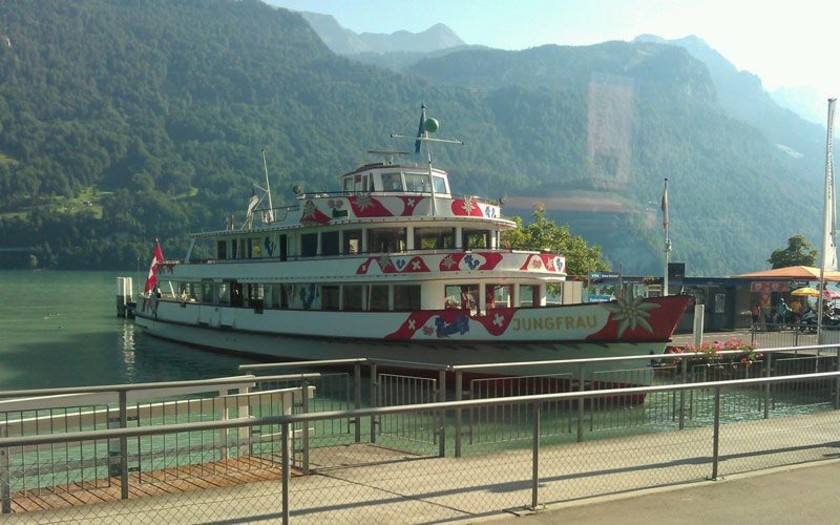
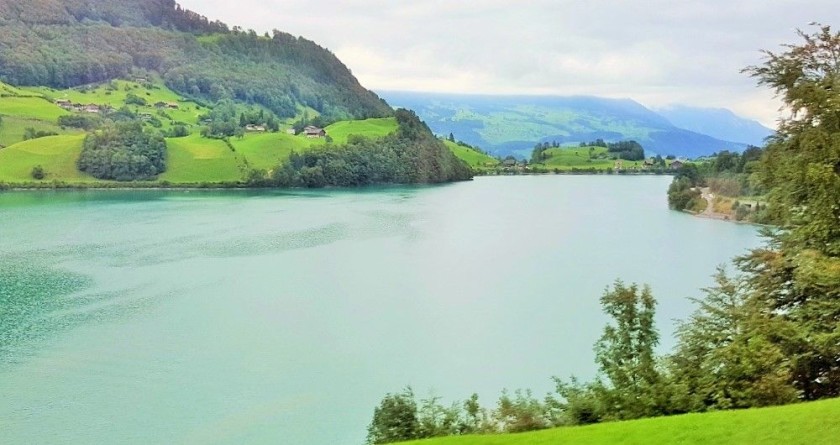
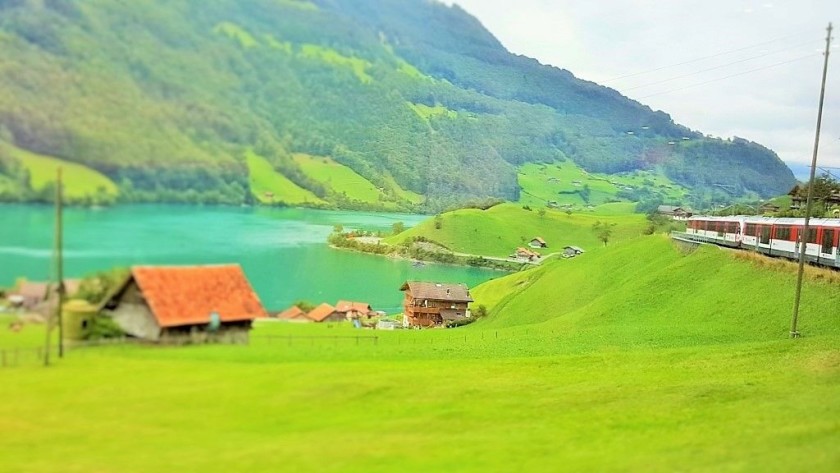

London ↔ Edinburgh
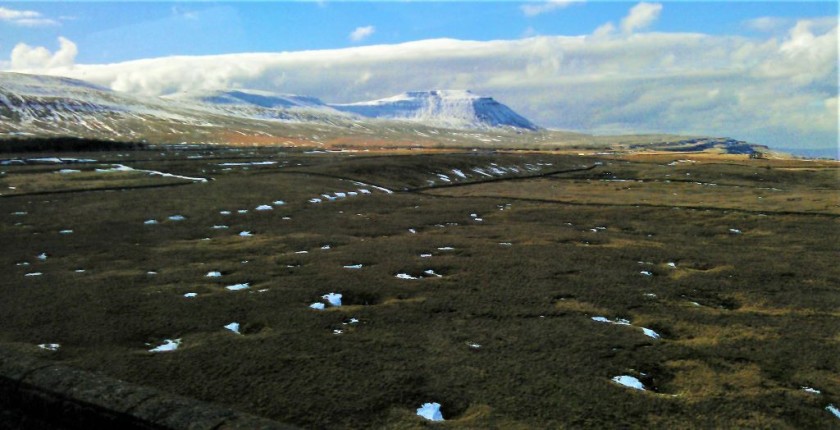
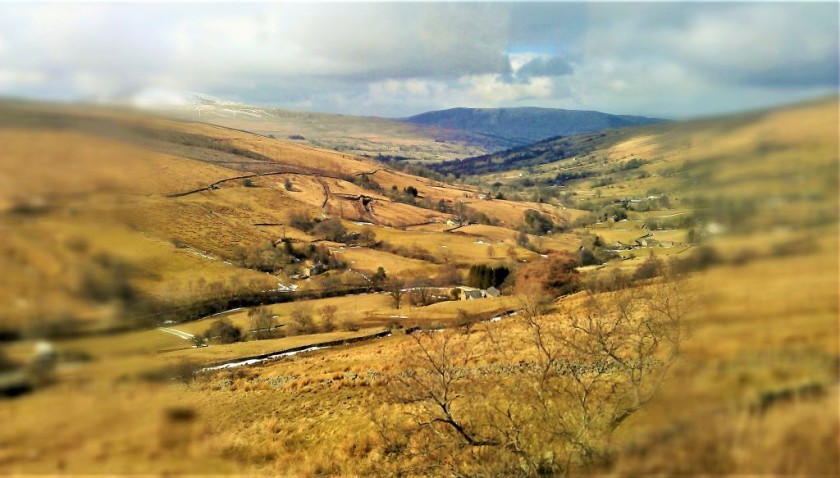
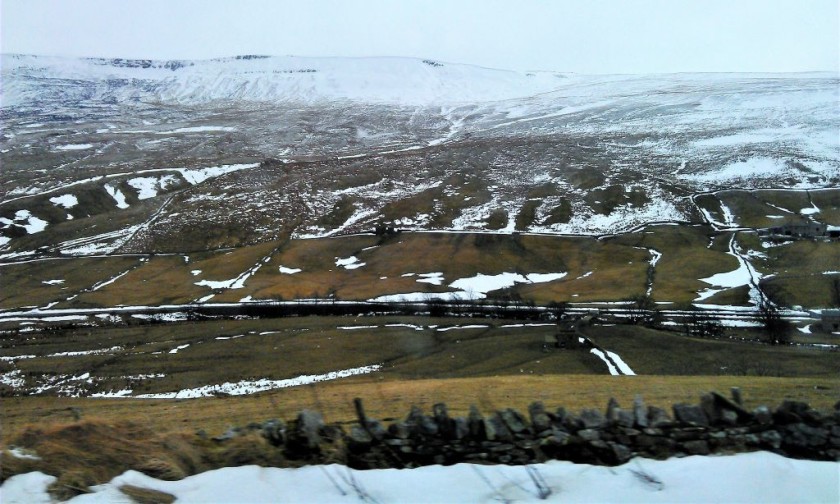
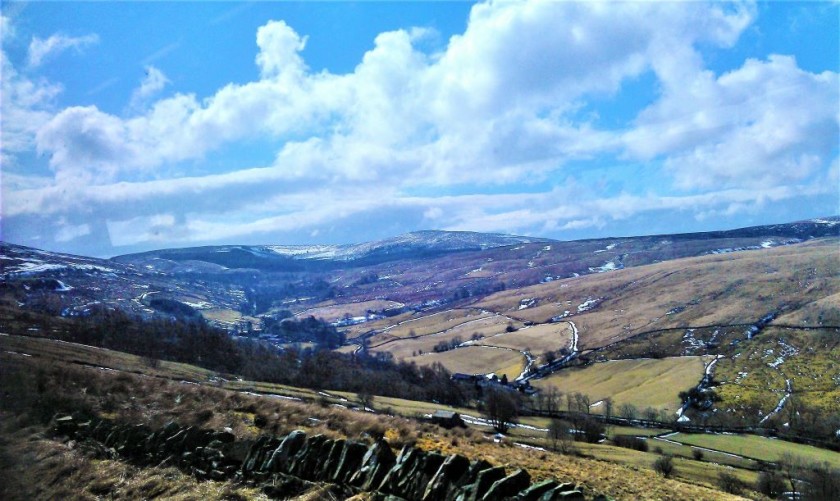
Taking this route = 7hr 30min approx
by direct train = 4hr 30min approx
Yes the northern half of the route taken by the direct trains, the section of the journey between Durham and Edinburgh is rather wonderful, but if you will be using a rail pass to see the best of Britain by train it can be a great idea to take this route to Scotland and then whizz back to London on the direct trains.
Because if you come this way you can experience what is undoubtedly England's most spectacular journey by train.
The wild and empty landscapes that you will pass through don't lend themselves to frequent train services, so it's a minor miracle that the opportunity to travel from Leeds to Carlisle across the dramatic Pennine Hills, is still a possibility.
Plus the part of the journey between Carlisle and Edinburgh showcases a dramatic route across the Southern Uplands of Scotland, so on the end-to-end journey, the fabulous views from the train windows can be enjoyed for more than three hours.
Heading north the usual connections are:
Monday to Saturday:
- London to Leeds at 10:07
- Leeds to Carlisle at 13:18
- Carlisle to Edinburgh at 16:14; arrive Edinburgh Waverley at 17:33.
Sunday:
Monday to Saturday: - London to Leeds at 09:03
- Leeds to Carlisle at 12:32
- Carlisle to Edinburgh at 16:16; arrive Edinburgh Waverley at 17:39.
Heading south the usual connections are:
Monday to Saturday:
- Edinburgh to Carlisle at 12:12, though this train is due to arrive in Carlisle only 10mins before the departure of,
- Carlisle to Leeds at 10:40
- Leeds to London King's Cross at 16:15 (10 min connection) or at 16:45, arrives London at 19:01.
Sunday: - Edinburgh to Carlisle at 10:13
- Carlisle to Leeds at 12:23
- Leeds to London King's Cross at 15:08; arrives London at 18:27.
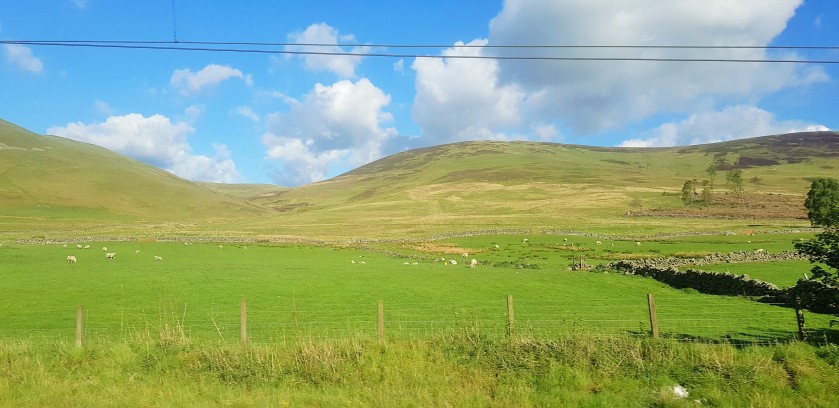
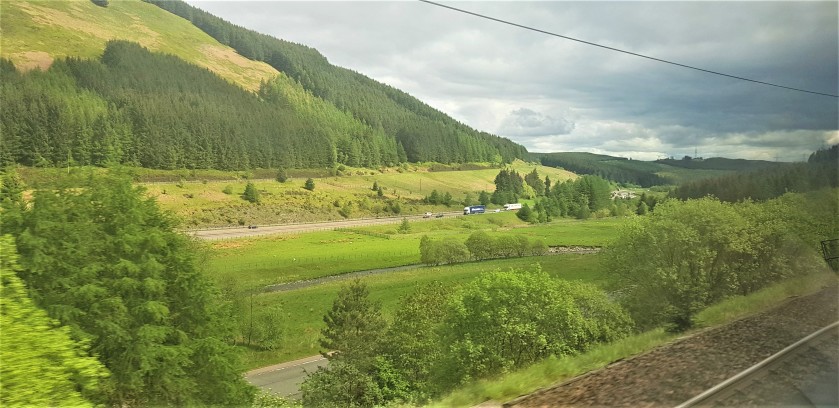
Paris ↔ Köln/Cologne
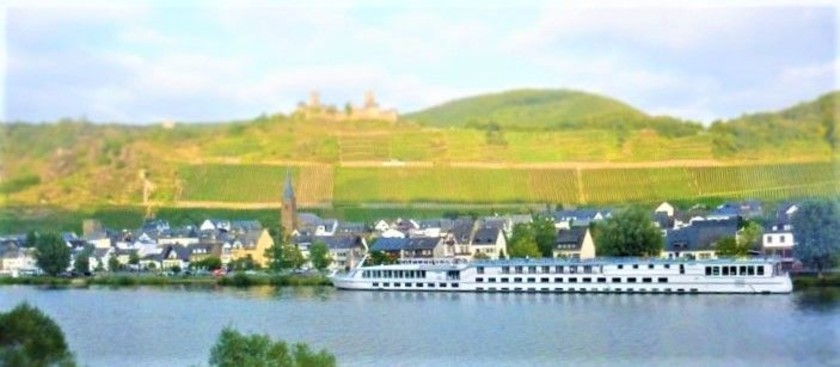

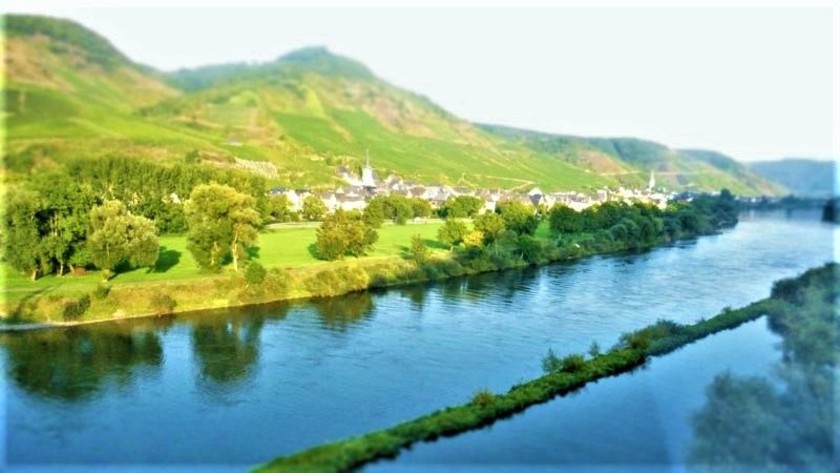
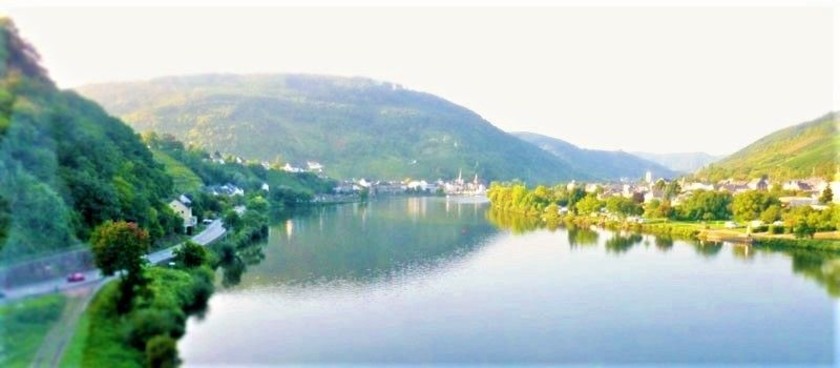
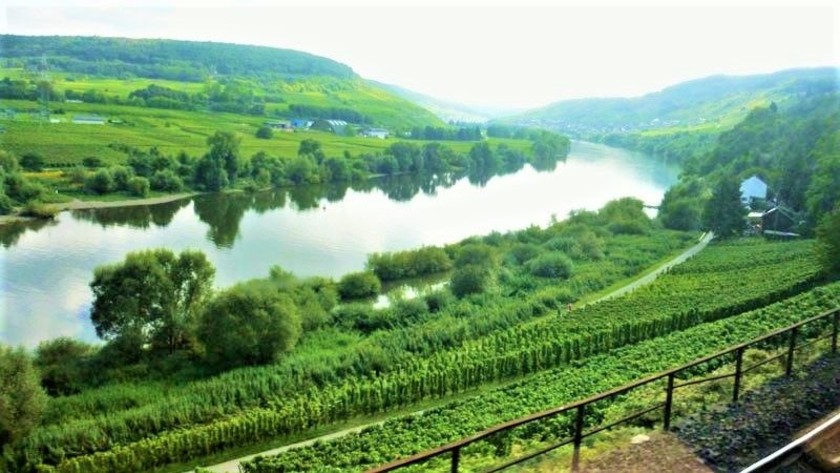

Taking the slow route = from 6hr 25min approx
by direct train = 3hr 20min approx
Rail pass users typically save = more than €20
The flat landscapes of north-west mainland Europe are ideal territory for high speed railways, hence the only wow factor of journeys by the direct Paris ↔ Köln/Cologne journeys by Thalys trains being their speed.
In contrast this alternative route involves experiencing more than two hours of some of the best river valley views in all of Europe.
Also, if you will be travelling with a rail pass, the mandatory reservation fees on the TGV trains between Paris and Luxembourg are much cheaper than those which Eurail and InterRail have to pay on those Thalys trains.
The Koblenz-Trier Railway follows the path carved by Moselle River through a stunning valley, the best of the views from the upper deck of the double-deck trains are on the right when heading north towards Koblenz; so are on the left when heading south.
The Regional-Express trains which take this line, travel beyond Trier in order to depart from and arrive at the main station in Luxembourg, where they connect with the TGV high-speed trains that travel between Paris and Luxembourg.
The railway between Koblenz and to the north of Bonn hugs the west bank of the River Rhine, so the views over the river can be seen on the right when heading north; so are on the left when heading south.
The usual connections from Paris to Köln/Cologne are,
Monday to Saturday:
- Paris Est to Luxembourg at 10:40
- Luxembourg to Koblenz at 13:33
- Koblenz to Koln by EC train on which some of the first class seats are in an observation car, at 16:13; arrive Koln Hbf at 17:05.
Sunday
- Paris Est to Luxembourg at 10:40
- Luxembourg to Koblenz at 14:33
- Koblenz to Koln by ICE train at 17:13; arrive Koln Hbf at 18:05.
The usual daily connections from Köln/Cologne to Paris are:
- Koln Hbf to Koblenz by ICE train at 09:53
- Koblenz to Luxembourg at 11:06
- Luxembourg to Paris Est at 14:10, arrives Paris at 16:31.
Frankfurt (Main) ↔ Köln/Cologne
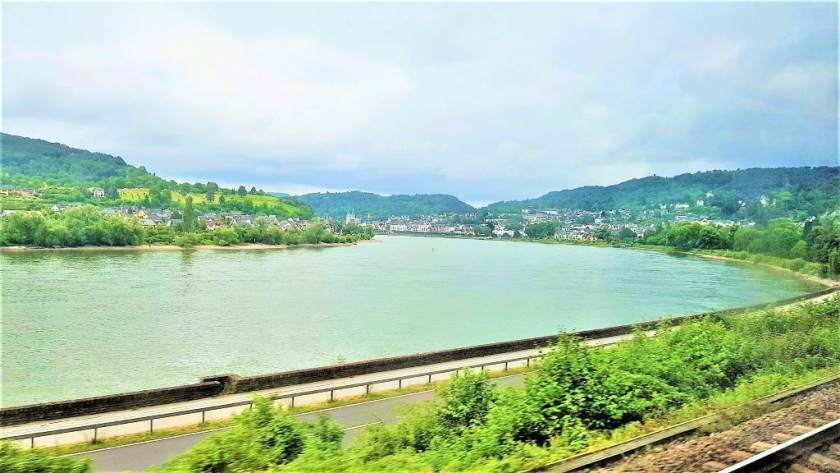
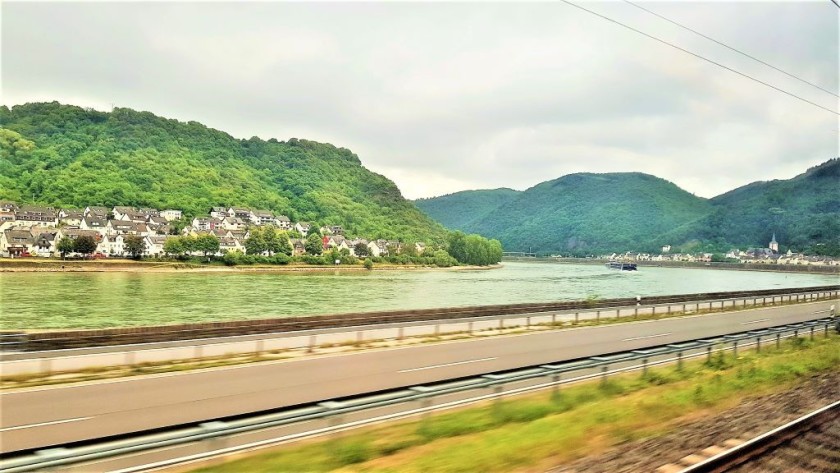
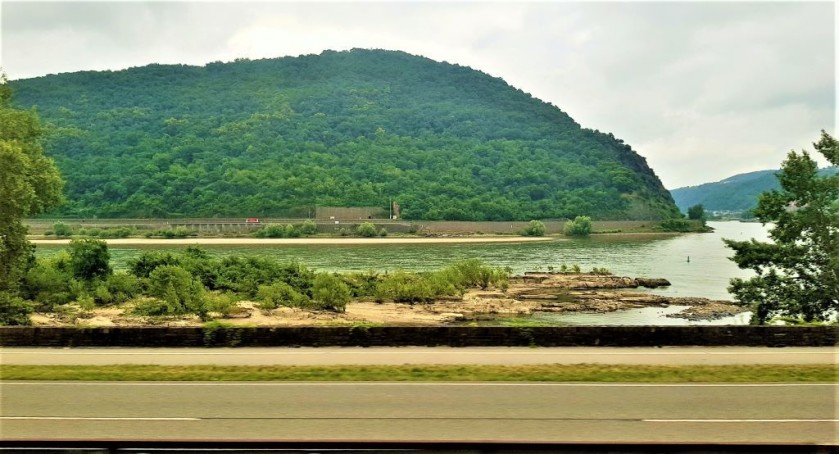
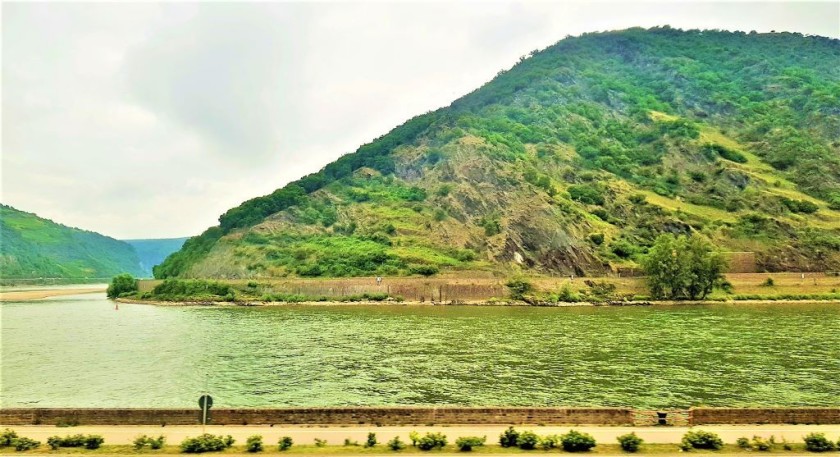
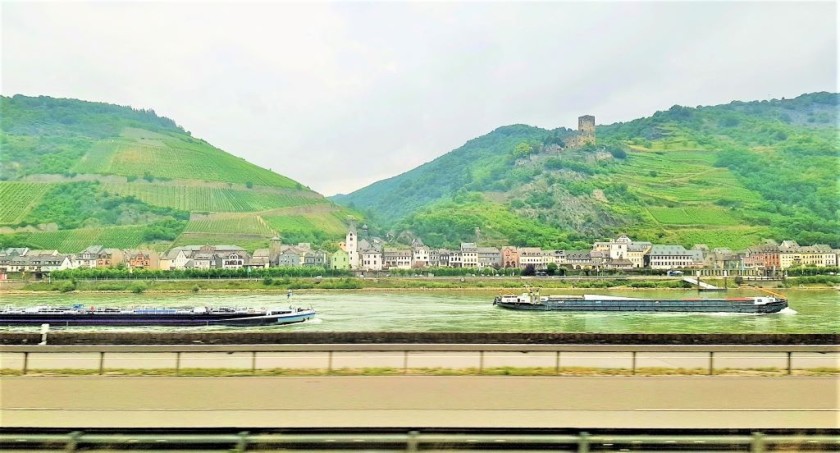
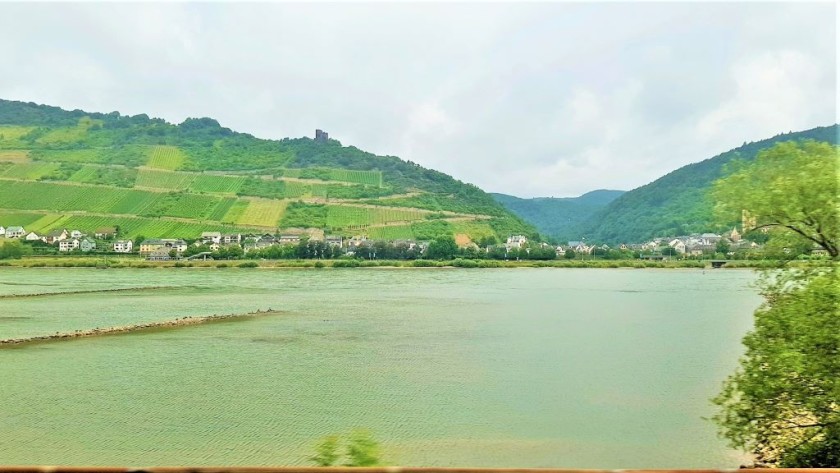
these trains = 2hr 30min approx
ICE trains = from 1hr 8min approx
If you have seen a promotion for a European river cruise, the boat which has been filmed or pictured will, more often than not, be travelling through The Rhine Gorge.
It's due to the fact that it's a fantastic river landscape, in which enigmatic castles seem to float on the clifftops which rise up from the water, but you can also travel through it by train.
The views over the river are on the left when heading south and the right when heading north, so they're on the right when travelling towards Köln/Cologne.
This contender for Germany's most scenic journey by train, used to be the the country's main north to south rail route, but in 2002 a high speed line between Köln/Cologne and Frankfurt (Main) opened, so most, but not all, of the sleek ICE trains between the two cities now rush along it at more than 270 km/h.
It isn't only the speed attained by those trains which has transformed the fastest travel time, as the new line is also much straighter, but what makes this older route special, is that follows the curves of the river bank.
It is the sense of what thrilling view will be seen around the next bend, which makes the journey by train through The Rhine Gorge so wonderful.
The highlights of the journey come between Koblenz and Bochum, with the part of the journey north of Koblenz acting as a preview of what is to come when heading south
Though departures need to be chosen with care if you want to come the way, as most of the trains which travel through Koblenz, don't serve the main station in Frankfurt, namely Frankfurt (Main) hbf.
The high speed trains are more frequent between Köln/Cologne and Frankfurt, though an advantage of the express trains which take the river route, is that they all typically arrive at and depart from the city's main station, Koln Hbf; many of the high speed trains use a secondary station in the city.
Salzburg ↔ Wien/Vienna

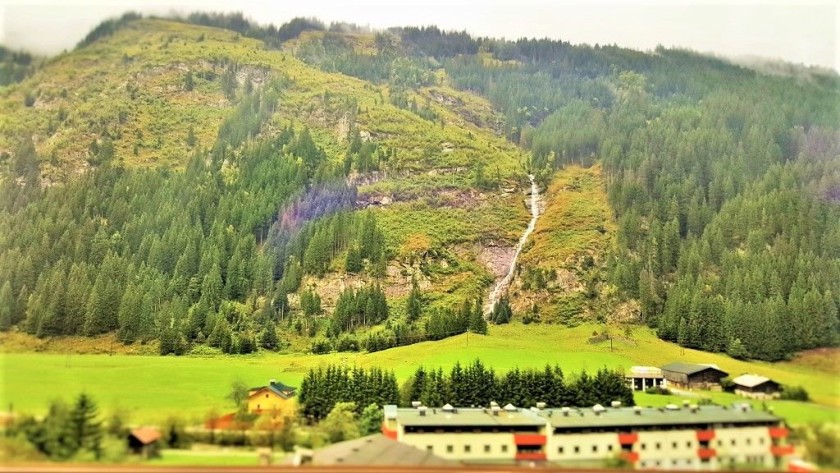
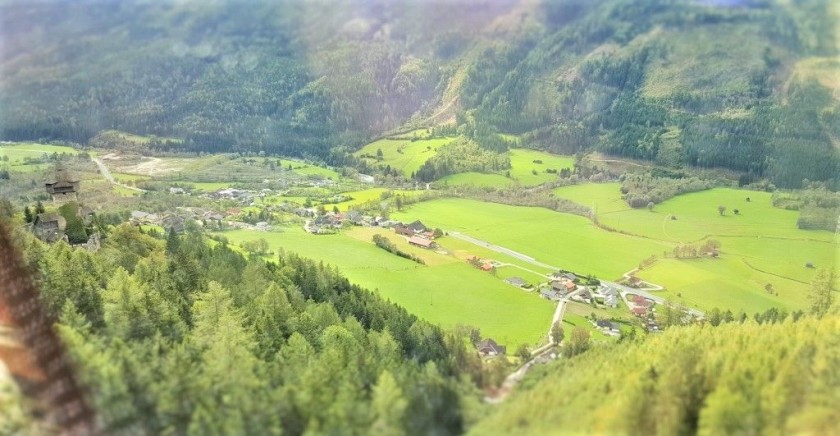
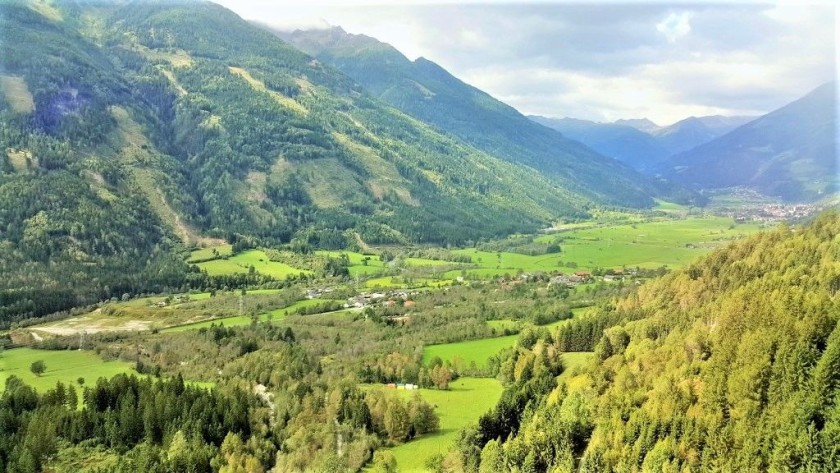
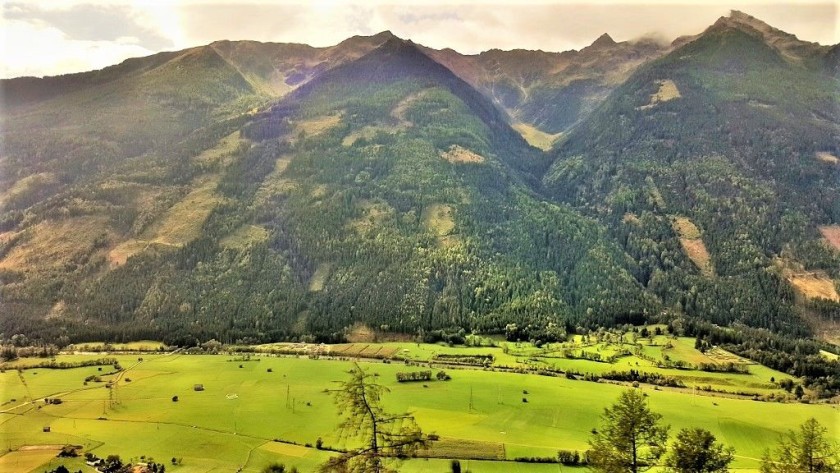
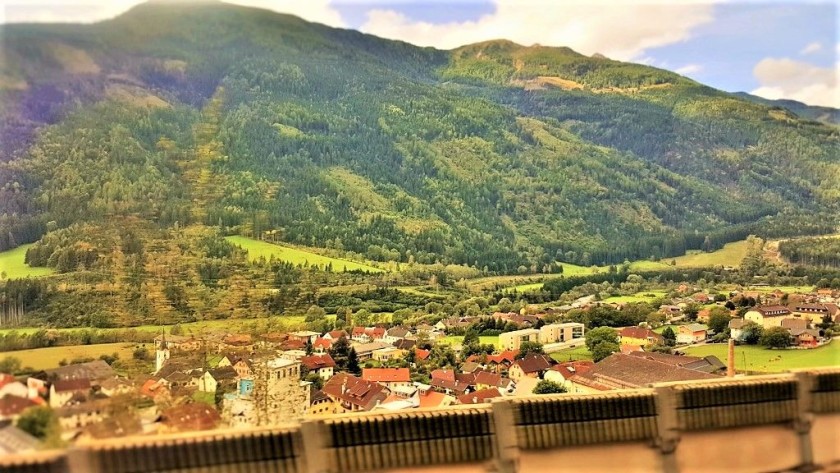
this route = 6hr 20 min approx
direct trains = from 2hr 22min
The express trains between Salzburg and Wien used to take a route that's prettier than the current journey, as the trains now spend most of the part of the journey between Linz and the Austrian capital traveling on a newer, but duller, railway.
Though the direct trains between Salzburg and Wien have never provided a dramatic journey, but other express trains in Austria take some of the most scenic railway routes to be found anywhere in Europe.
Which is why if you'll be spending time in both Salzburg and the capital and also want to experience dramatic landscapes while you're in Austria, then it's worth taking this diversion.
Yes the travel time will be three times longer, but for around 80% of the trip you will be experiencing some of the most dramatic views which can be seen from European express trains.
Every two hours during the day, express trains depart Salzburg for Klagenfurt, and they take a stunning with numerous highlights;
by the River Salzach, on the right,
the ascent to Bad Gastein, on the left
the journey on towards The Tauern Tunnel, on the right
the descent to Villach after The Tauern Tunnel, on the right
and passing by the Worthersee, on the right.
Klagenfurt is connected to Wien/Vienna by hourly trains and they also take one of Europe's most fabulous railway journeys.
The passage along the UNESCO listed Semmering Railway north of Bruck an der Mur steals the limelight, but this part of the journey is a sequence of jaw-dropping, but fleeting views.
The landscape the train travels through between Klagenfurt and Leoben isn't as dramatic, but it can be savored for longer.
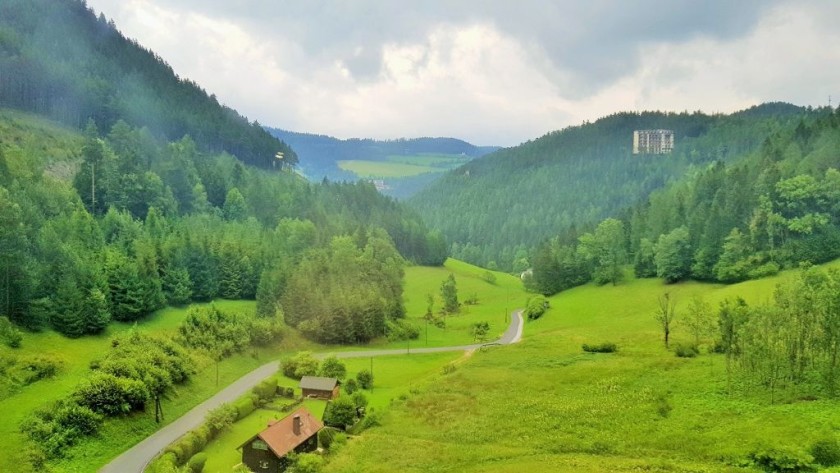
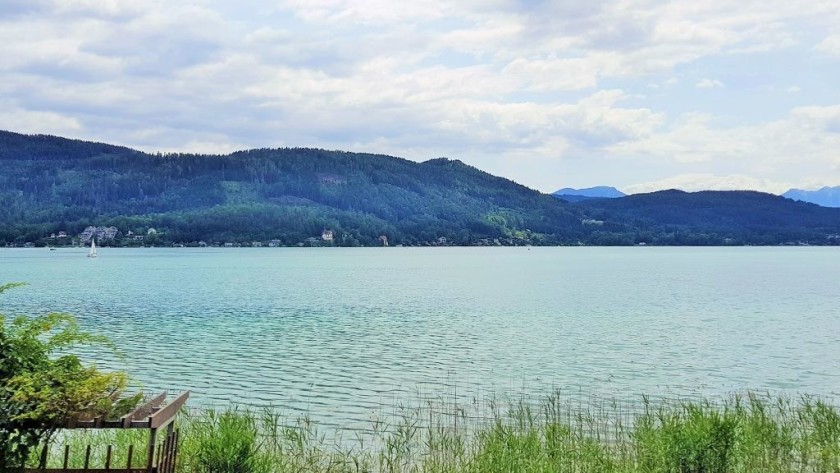
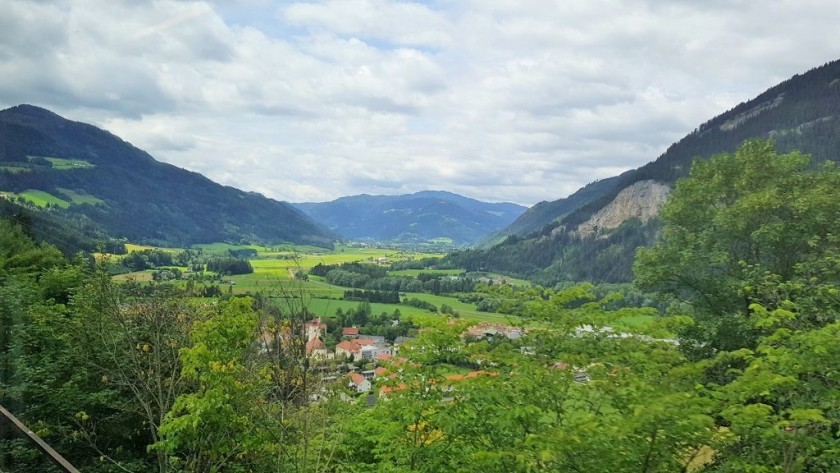
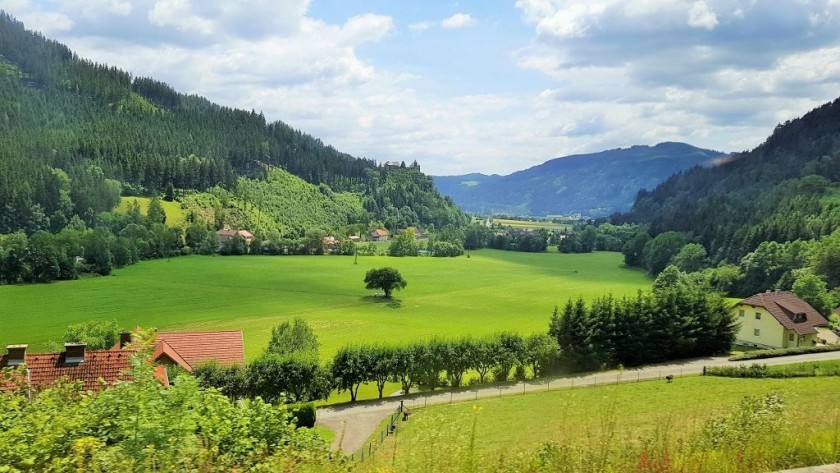
Look for a journey guide
Please support ShowMeTheJourney
This second version of ShowMeTheJourney is exciting and new, so we are genuinely thrilled that you are here and reading this, but we also need your help.
We’re striving not to let anything get in the way of providing the most useful service possible, hence a facility has been set up with DonorBox which can be used to support the running costs and make improvements.
Instead of advertising or paywalls, your financial support will make a positive difference to delivering an enhanced service, as there’s a lot of ideas which we want to make happen.
So if you have found the info provided here to be useful, please go here to say thank you.

Simon Harper
I wanted to share my passion for train travel and explain how anyone can take the fantastic journeys I have taken.

This is one of more than 100 train travel guides available on ShowMeTheJourney, which will make it easier to take the train journeys you want or need to make. As always, all images were captured on trips taken by ShowMeTheJourney.
This second version of ShowMeTheJourney is exciting and new, so we are genuinely thrilled that you are here and reading this, but we also need your help.
We’re striving not to let anything get in the way of providing the most useful service possible, hence a facility has been set up with DonorBox which can be used to support the running costs and make improvements.
Instead of advertising or paywalls, your financial support will make a positive difference to delivering an enhanced service, as there’s a lot of ideas which we want to make happen.
So if you have found the info provided here to be useful, please consider saying thank you.









